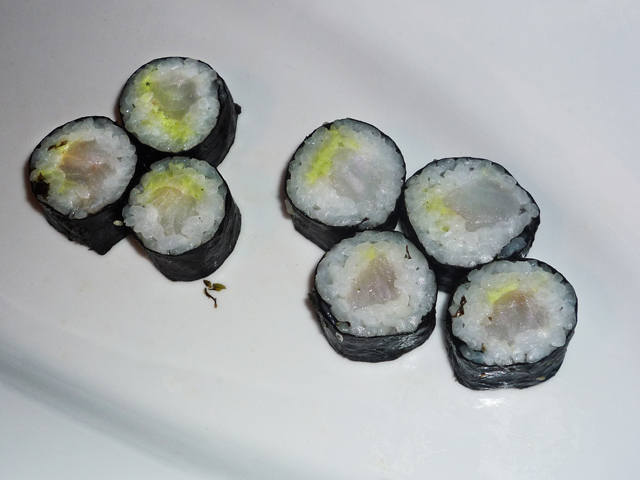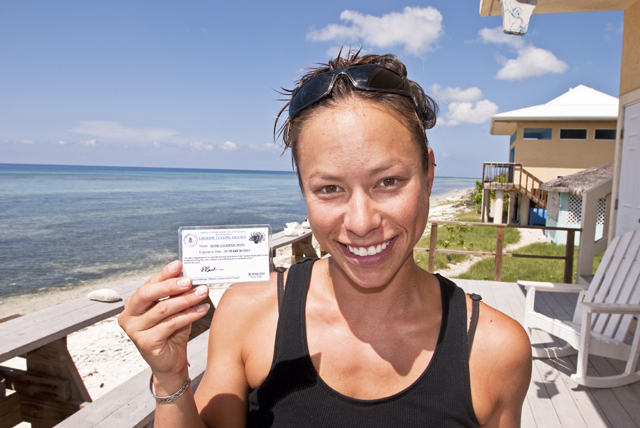Marine Life & Conservation Blogs
Licensed to Cull
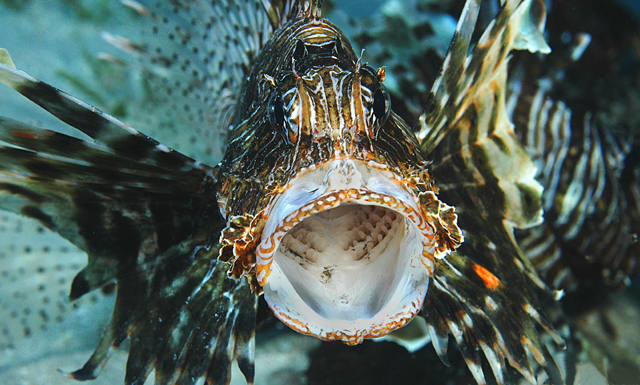
Over the past few years lionfish have been dominating the news headlines. In fact they are probably the most talked about marine species in the Caribbean. There are even ‘wanted’ posters on display in many dive centres. But these posters are not advertising underwater photography or promoting marine life; they are basically ‘kill on sight’ orders.
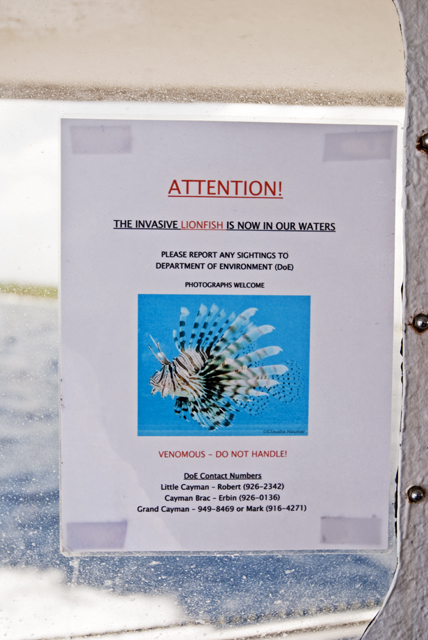 In the Red Sea lionfish (Pterois volitans) are extremely popular with divers. Their bold stripy colours and large venomous spines look great in photographs and they are fascinating to watch, especially when hunting in packs. But the Atlantic Ocean is not their home territory and what’s deemed as an attraction on one continent is seriously threatening the very existence of another.
In the Red Sea lionfish (Pterois volitans) are extremely popular with divers. Their bold stripy colours and large venomous spines look great in photographs and they are fascinating to watch, especially when hunting in packs. But the Atlantic Ocean is not their home territory and what’s deemed as an attraction on one continent is seriously threatening the very existence of another.
During a recent trip to the Cayman Islands I spoke with Flower Moye, a researcher for the CCMI (Central Caribbean Marine Institute) based on Little Cayman. She said that the most likely theory is the whole disaster had been caused by a freak accident. Flower said the Caribbean ‘strain’ had probably been released by aquariums somewhere near Miami. They are now sweeping from island to island heading due south. Some have even been reported as far away as Belize. Flower said “we are not sure where they are or where they are going”. She thinks the present crisis could have been caused by as little as 6 original lionfish. She also thought they were dealing with 2 separate species.
Flower said that the Caymans are now on a lionfish high alert. The ‘hardcore scramble’ started in 2007. Two researchers from Oregon State University were taken on to solely study lionfish characteristics. They are checking sizes, weights and DNA strings to see where they originated from. Studies have shown that the Caribbean lionfish are actually growing in size. They have already exceeded their normal length by a massive 15cm and are still getting bigger. This invasive species has no natural enemies so are just decimating one reef after another. Flower said “no one was prepared or expected such an aggressive full on attack”.
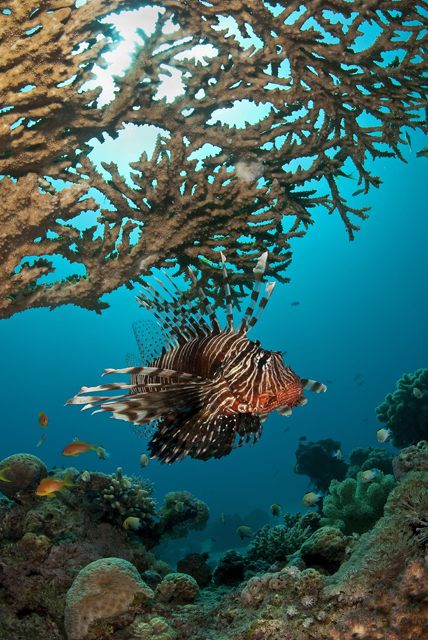
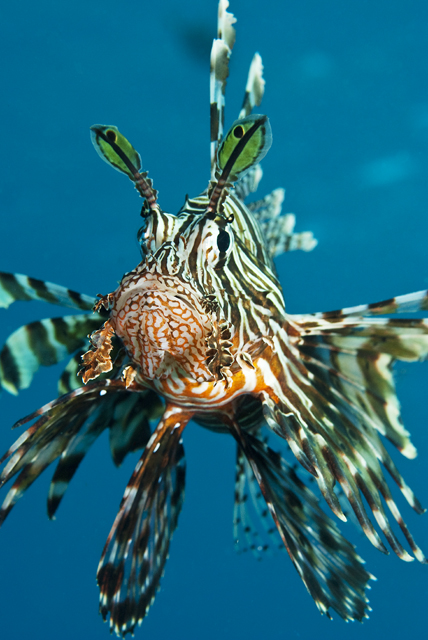 The alien invasion has now reached critical levels and is threatening the whole eco-system. Lionfish are just eating their way through entire cleaning stations. Flower said a dissected specimen had more than 32 fish in its stomach. The local fish population just don’t know how to react. The voracious predator is herding up the unsuspecting fish using their spines and then it’s a full on feeding frenzy. Divers recorded one individual eating 20 juveniles in 30 minutes. Their main targets are damsels and cardinals but every species is under threat. Flower said that the survival rate for reef inhabitants has reduced by a staggering 80 percent. This has a huge knock on effect. The loss of grazers like parrotfish means seaweeds and algae can thrive. This will eventually overwhelm the coral reefs.
The alien invasion has now reached critical levels and is threatening the whole eco-system. Lionfish are just eating their way through entire cleaning stations. Flower said a dissected specimen had more than 32 fish in its stomach. The local fish population just don’t know how to react. The voracious predator is herding up the unsuspecting fish using their spines and then it’s a full on feeding frenzy. Divers recorded one individual eating 20 juveniles in 30 minutes. Their main targets are damsels and cardinals but every species is under threat. Flower said that the survival rate for reef inhabitants has reduced by a staggering 80 percent. This has a huge knock on effect. The loss of grazers like parrotfish means seaweeds and algae can thrive. This will eventually overwhelm the coral reefs.
Grand Cayman Authorities have realised the seriousness of the problem and are responding rapidly. It’s basically a case of exterminate or be exterminated. They have given divers the authorisation to actively seek out and destroy as many lionfish as possible. But before being issued with a license to cull they have to first sit through an hour long Powerpoint presentation. This explains the reasons behind the drastic measures, how to catch them (without getting stung) and what to do with them afterwards. Flower said the most humane way of killing them is to put them in the freezer so that they ‘go to sleep’ and then bury them on land or eat them.
Some divers are even grilling lionfish steaks on the barbecue but obviously the poisonous spines have to be cut off with scissors before the fleshy parts can be sliced up into pieces. Gladys, the owner of Pirates Point on Little Cayman, had prepared some lionfish Sushi for me. I tried a few pieces and although it had a strange twangy taste, it wasn’t at all offensive or inedible. Adding some Wasabi was all it took to spice up the flavour and make it palatable. At Cobalt Coast resort they invited me to a lionfish cook out where I tried all sorts of dishes from deep fried goujons to an extremely tasty bouillabaisse. At least lionfish was proving good to eat!
Dive guides are even trying to ‘train’ the local Nassau grouper population to eat the lionfish. Laura, an Instructor working at the Little Cayman Beach resort, dropped a freshly caught lionfish in front of a grouper and after a few seconds of deliberation it decided to take a bite. But unless the lionfish are actually placed in front of them they don’t seem to be interested. It’s just not seen as a natural food source.
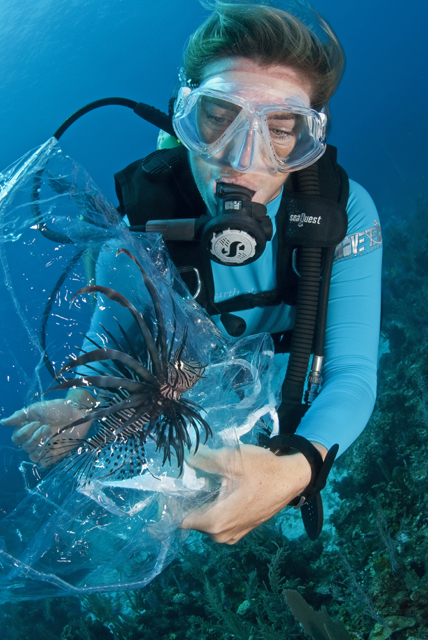 I went for a quick dive with Laura hunting for lionfish and within 10 minutes we managed to find one under a coral mount. Laura scooped the lionfish into a plastic bag and then put it into an ice box back on board the boat. All sightings are reported to the D.O.E. so they can get a good idea where they are and in what numbers. But lionfish are proving a tough species to eradicate. They adapt very quickly. At one dive site I searched below 40 metres and found a number of big 20 – 30cm lionfish lurking underneath ledges all along the wall. I’m sure they had cottoned on that recreational divers don’t usually go this deep so there was less likelihood of being caught.
I went for a quick dive with Laura hunting for lionfish and within 10 minutes we managed to find one under a coral mount. Laura scooped the lionfish into a plastic bag and then put it into an ice box back on board the boat. All sightings are reported to the D.O.E. so they can get a good idea where they are and in what numbers. But lionfish are proving a tough species to eradicate. They adapt very quickly. At one dive site I searched below 40 metres and found a number of big 20 – 30cm lionfish lurking underneath ledges all along the wall. I’m sure they had cottoned on that recreational divers don’t usually go this deep so there was less likelihood of being caught.
The licenses are proper looking ID cards complete with a head and shoulders photograph of the holder. The culling is being promoted as a form of ‘pest control’. But numbers are still growing at an incredible rate. Lionfish can release up to 30,000 eggs a month which equates to more than 2,000,000 eggs every year. Flower said that when they grow to a size of 10cm they are ready to spawn and from then on will keep spawning every 4 days for the rest of their lives! At present there seems to be very little information available on mating habits etc. The only way of finding out the sex of each individual fish is to dissect it. Flower estimates that numbers around Little Cayman are in the high hundreds but this is considered to be a very conservative estimation. In 2008 a researcher caught a total of 197 Lionfish in a small defined area.
At present there is no long term solution to the Lionfish catastrophe. These underwater terminators are not afraid of anything and literally can’t be stopped. In other parts of the world reef fish have learnt to avoid them and there are more natural predators like groupers or stonefish keeping population levels in check. Unfortunately Caribbean grouper numbers have fallen dramatically due to overfishing. This situation requires a more drastic approach but introducing another ‘alien’ species specifically to kill the lionfish is not seen as a good idea. Flower said “Having 2 invasives will not solve the problem and could in fact just make the situation a whole lot worse”. And so the war continues….
Blogs
The Ocean Cleanup Breaks 10,000,000 KG Barrier

The Ocean Cleanup, the global non-profit project, has removed a verified all-time total of ten million kilograms (22 million lbs.) of trash from oceans and rivers around the world – approximately the same weight as the Eiffel Tower.
To complete its mission of ridding the oceans of plastic, The Ocean Cleanup uses a dual strategy: cleaning up the Great Pacific Garbage Patch (GPGP) to remove the plastic already afloat in the oceans, while stopping the flow of plastic from the world’s most polluting rivers.
Through cleaning operations in the GPGP and in rivers in eight countries, the cumulative total of trash removed has now surpassed ten million kilograms. This milestone demonstrates the acceleration of The Ocean Cleanup’s impact, while underlining the astonishing scale of the plastic pollution problem and the need for continued support and action.
While encouraging for the mission, this milestone is only a staging point: millions more tons of plastic still pollute our oceans and The Ocean Cleanup intends to continue learning, improving and innovating to solve this global catastrophe.
This announcement comes as governments from around the world meet to continue negotiations to develop a new legally binding instrument to end plastic pollution at INC4 in Ottawa, Canada. Representatives of The Ocean Cleanup will be in attendance and the organization will be urging decision-makers to collaborate towards a comprehensive and ambitious global treaty which addresses plastic at all stages of its life cycle and in all marine environments worldwide, including in areas beyond national jurisdiction.
It is encouraging to see that the need for remediation is reflected in the various options for potential treaty provisions. It is essential that the final treaty contains clear targets for the remediation of legacy plastic pollution, and reduction of riverine plastic emissions.
Tackling plastic pollution requires innovative and impactful solutions. The treaty should therefore incentivize the innovation ecosystem by fostering innovations that make maximal use of data, technology and scientific knowledge – such as those designed and deployed by The Ocean Cleanup.
‘After many tough years of trial and error, it’s amazing to see our work is starting to pay off – and I am proud of the team who has brought us to this point.’ said Boyan Slat, Founder and CEO of The Ocean Cleanup. ‘While we still have a long way to go, our recent successes fill us with renewed confidence that the oceans can be cleaned.’
The Ocean Cleanup was founded in 2013 and captured its first plastic in 2019, with the first confirmed catch in the GPGP coming soon after the deployment of Interceptor 001 in Jakarta, Indonesia. After surpassing one million kilograms of trash removed in early 2022, the non-profit project has since progressed to the third iteration of its GPGP cleaning solution, known as System 03, and a network of Interceptors currently covering rivers in eight countries, with more deployments set for 2024.
About The Ocean Cleanup
The Ocean Cleanup is an international non-profit organization that develops and scales technologies to rid the world’s oceans of plastic. They aim to achieve this goal through a dual strategy: stemming the inflow via rivers and cleaning up the legacy plastic that has already accumulated in the ocean. For the latter, The Ocean Cleanup develops large-scale systems to efficiently concentrate the plastic for periodic removal. This plastic is tracked and traced through DNV’s chain of custody model to certify claims of origin when recycling it into new products. To curb the tide via rivers, The Ocean Cleanup has developed Interceptor™ solutions to halt and extract riverine plastic before it reaches the ocean. Founded in 2013 by Boyan Slat, The Ocean Cleanup now employs a broadly multi-disciplined team of approximately 140. The foundation is headquartered in Rotterdam, the Netherlands.
For more information, visit: theoceancleanup.com and follow @theoceancleanup on social media.
Marine Life & Conservation Blogs
Creature Feature: Dusky Shark

 In this series, the Shark Trust will be sharing amazing facts about different species of sharks and what you can do to help protect them.
In this series, the Shark Trust will be sharing amazing facts about different species of sharks and what you can do to help protect them.
This month we’re taking a look at the Dusky Shark, a highly migratory species with a particularly slow growth rate and late age at maturity.
Dusky sharks are one of the largest species within the Carcharhinus genus, generally measuring 3 metres total length but able to reach up to 4.2 metres. They are grey to grey-brown on their dorsal side and their fins usually have dusky margins, with the darkest tips on the caudal fin.
Dusky Sharks can often be confused with other species of the Carcharhinus genus, particularly the Galapagos Shark (Carcharhinus galapagensis). They have very similar external morphology, so it can be easier to ID to species level by taking location into account as the two species occupy very different ecological niches – Galapagos Sharks prefer offshore seamounts and islets, whilst duskies prefer continental margins.
Hybridisation:
A 2019 study found that Dusky Sharks are hybridising with Galapagos Sharks on the Eastern Tropical Pacific (Pazmiño et al., 2019). Hybridisation is when an animal breeds with an individual of another species to produce offspring (a hybrid). Hybrids are often infertile, but this study found that the hybrids were able to produce second generation hybrids!
Long distance swimmers:
Dusky sharks are highly mobile species, undertaking long migrations to stay in warm waters throughout the winter. In the Northern Hemisphere, they head towards the poles in the summer and return southwards towards the equator in winter. The longest distance recorded was 2000 nautical miles!
Very slow to mature and reproduce:
The Dusky Shark are both targeted and caught as bycatch globally. We already know that elasmobranchs are inherently slow reproducers which means that they are heavily impacted by overfishing; it takes them so long to recover that they cannot keep up with the rate at which they are being fished. Dusky Sharks are particularly slow to reproduce – females are only ready to start breeding at roughly 20 years old, their gestation periods can last up to 22 months, and they only give birth every two to three years. This makes duskies one of the most vulnerable of all shark species.
The Dusky Shark is now listed on Appendix II of the Convention on the Conservation of Migratory Species (CMS), but further action is required to protect this important species.
Scientific Name: Carcharhinus obscurus
Family: Carcharhinidae
Maximum Size: 420cm (Total Length)
Diet: Bony fishes, cephalopods, can also eat crustaceans, and small sharks, skates and rays
Distribution: Patchy distribution in tropical and warm temperate seas; Atlantic, Indo-Pacific and Mediterranean.
Habitat: Ranges from inshore waters out to the edge of the continental shelf.
Conservation status: Endangered.
For more great shark information and conservation visit the Shark Trust Website
Images: Andy Murch
Diana A. Pazmiño, Lynne van Herderden, Colin A. Simpfendorfer, Claudia Junge, Stephen C. Donnellan, E. Mauricio Hoyos-Padilla, Clinton A.J. Duffy, Charlie Huveneers, Bronwyn M. Gillanders, Paul A. Butcher, Gregory E. Maes. (2019). Introgressive hybridisation between two widespread sharks in the east Pacific region, Molecular Phylogenetics and Evolution 136(119-127), https://doi.org/10.1016/j.ympev.2019.04.013.
-

 News3 months ago
News3 months agoCapturing Critters in Lembeh Underwater Photography Workshop 2024: Event Roundup
-

 Marine Life & Conservation Blogs3 months ago
Marine Life & Conservation Blogs3 months agoCreature Feature: Swell Sharks
-

 Blogs2 months ago
Blogs2 months agoMurex Resorts: Passport to Paradise!
-

 Blogs2 months ago
Blogs2 months agoDiver Discovering Whale Skeletons Beneath Ice Judged World’s Best Underwater Photograph
-

 Gear Reviews3 weeks ago
Gear Reviews3 weeks agoGEAR REVIEW – Revolutionising Diving Comfort: The Sharkskin T2 Chillproof Suit
-

 Gear Reviews3 months ago
Gear Reviews3 months agoGear Review: Oceanic+ Dive Housing for iPhone
-

 Marine Life & Conservation2 months ago
Marine Life & Conservation2 months agoSave the Manatee Club launches brand new webcams at Silver Springs State Park, Florida
-

 News2 months ago
News2 months agoPADI Teams Up with Wellness Brand Neuro to Drive Ocean Change and Create a Blue State of Mind


